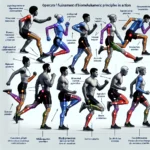Mobility exercises are an essential component of physical fitness and overall well-being. As an IELTS learner, understanding this concept and its related vocabulary can significantly enhance your performance in the exam. Let’s delve into the world of mobility exercises and explore how you can effectively use this terminology in your IELTS preparation.
Understanding Mobility Exercises
Mobility exercises (noun, /məʊˈbɪləti ˈeksəsaɪzɪz/)
Definition: Physical activities designed to improve the range of motion in joints and muscles, enhancing flexibility and reducing the risk of injury.
 Mobility exercises demonstration
Mobility exercises demonstration
Context and Usage
-
Athletes incorporate mobility exercises into their warm-up routines to prepare their bodies for intense training sessions.
Analysis: This sentence demonstrates the practical application of mobility exercises in a sports context. The phrase “incorporate into” shows how these exercises are integrated into a broader fitness regimen.
-
The physical therapist recommended daily mobility exercises to improve the patient’s joint flexibility after surgery.
Analysis: Here, we see the medical application of mobility exercises. The use of “recommended” indicates their importance in rehabilitation processes.
-
Many office workers perform mobility exercises during their breaks to counteract the effects of prolonged sitting.
Analysis: This example illustrates the relevance of mobility exercises in everyday life, particularly for those with sedentary jobs.
-
The yoga instructor emphasized the importance of mobility exercises for maintaining a healthy spine and preventing back pain.
Analysis: This sentence showcases the preventive aspect of mobility exercises, linking them to long-term health benefits.
-
As part of their training program, gymnasts dedicate a significant portion of their practice to mobility exercises, ensuring they maintain the flexibility required for complex routines.
Analysis: This example highlights the specific application of mobility exercises in a sport that demands extreme flexibility, emphasizing their crucial role in specialized athletic training.
Frequency in IELTS
Mobility exercises are most likely to appear in IELTS Reading and Listening tests, particularly in passages or conversations related to health, fitness, or sports. They may also be relevant in Writing Task 2 essays discussing topics such as public health or the importance of physical education.
Vocabulary Analysis
Word Structure
- Mobility: from Latin “mobilis” meaning movable
- Exercises: from Latin “exercere” meaning to keep busy, practice
Synonyms and Antonyms
-
Synonyms:
- Flexibility training (noun, /ˌfleksəˈbɪləti ˈtreɪnɪŋ/): Exercises focused on increasing the range of motion in muscles and joints.
- Range of motion exercises (noun phrase, /reɪndʒ əv ˈməʊʃən ˈeksəsaɪzɪz/): Activities designed to maintain or improve the movement of a specific joint or body part.
- Dynamic stretching (noun phrase, /daɪˈnæmɪk ˈstretʃɪŋ/): Active movements that stretch muscles to their full range of motion.
-
Antonyms:
- Static exercises (noun phrase, /ˈstætɪk ˈeksəsaɪzɪz/): Exercises performed in a stationary position without movement.
- Strength training (noun phrase, /streŋθ ˈtreɪnɪŋ/): Exercises focused on building muscle strength rather than flexibility.
Memory Techniques
Mind Mapping
Create a mind map with “Mobility Exercises” at the center, branching out to related concepts such as:
- Types (e.g., joint rotations, dynamic stretches)
- Benefits (e.g., improved flexibility, injury prevention)
- Applications (e.g., sports, rehabilitation, daily life)
- Related terms (e.g., range of motion, flexibility)
Storytelling
Imagine a character named “Mo Billie” who loves to move. Every morning, Mo starts with arm circles (mobility exercise for shoulders), then does leg swings (for hips), and finishes with torso twists (for the spine). Mo’s friends are amazed at how flexible and agile she is, all thanks to her daily mobility exercises!
Practice Exercises
-
Sentence Creation: Write three sentences using “mobility exercises” in different contexts (e.g., sports, healthcare, daily life).
-
Paragraph Writing: Compose a short paragraph explaining the importance of mobility exercises in maintaining overall health.
-
IELTS Task 2 Practice: Write an essay discussing the following question: “Some people believe that schools should allocate more time for physical education, including mobility exercises. Do you agree or disagree?”
Remember to review and practice using this term regularly to ensure long-term retention and fluency in its usage.
Conclusion
Understanding and being able to discuss mobility exercises can significantly enhance your IELTS performance, particularly in tasks related to health and fitness. By mastering this term and its related vocabulary, you’re not only improving your language skills but also gaining valuable knowledge about physical well-being.
We encourage you to incorporate these new terms into your daily English practice. Try using “mobility exercises” in conversations or writing exercises, and don’t hesitate to share your experiences or ask questions in the comments section below. How have you incorporated mobility exercises into your daily routine, and how has learning this term improved your English vocabulary?
For more information on related topics, you might find our articles on multi-joint exercises and stretching routines helpful in expanding your fitness vocabulary for IELTS.


